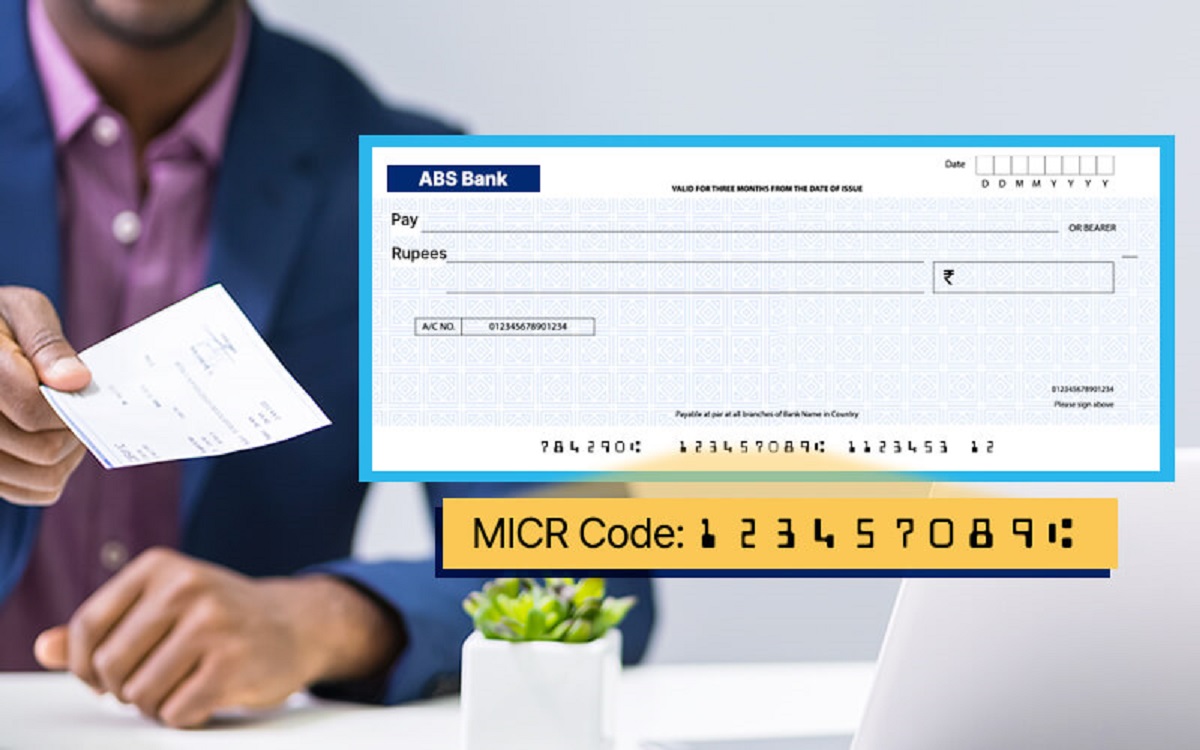Introduction
In today’s digital age, banking transactions have become faster and more efficient with the use of advanced technologies. One such technology that has revolutionized the banking industry is Magnetic Ink Character Recognition (MICR).
MICR is a system that allows the automatic processing of checks and other financial documents. It uses a unique combination of magnetic ink and specially designed fonts to encode important banking information on these documents.
Originally developed in the 1950s, MICR technology quickly gained popularity among financial institutions due to its accuracy, security, and reliability. It has drastically simplified the process of check clearing and banking transactions, offering a more efficient and error-free method compared to traditional manual processing.
The primary purpose of MICR is to facilitate the electronic processing of checks and other financial documents. By employing magnetic ink and the specific MICR fonts, important information such as the account number, bank routing number, and check number can be easily read and processed by high-speed scanning devices.
Furthermore, MICR technology provides an added layer of security to ensure that checks are not altered or tampered with. The unique magnetic ink used in MICR printing is resistant to tampering, making it difficult for fraudsters to modify or counterfeit checks.
The adoption of MICR technology by financial institutions has significantly streamlined the check processing system. Banks can now process large volumes of checks with speed and accuracy, reducing errors and fraud attempts. The increased efficiency not only benefits the bank but also the customers by providing faster check clearing and availability of funds.
In this article, we will delve deeper into the workings of MICR technology, its benefits, limitations, and its significance in the banking industry. We will also explore how MICR codes are used in banking and how to read them. So let’s unravel the fascinating world of MICR and discover its impact on modern banking operations.
What is MICR?
Magnetic Ink Character Recognition (MICR) is a widely used technology in the banking industry that allows the secure and automated processing of checks and other financial documents. It involves the use of magnetic ink and special characters to encode essential information that can be easily read and processed by machines.
The MICR system uses a unique set of characters, known as MICR characters or E-13B fonts, which are printed on the bottom of checks and other documents. These characters consist of a combination of numbers (0-9) and symbols, such as transit codes and account numbers, which hold crucial financial details.
The magnetic ink used in MICR printing contains iron oxide particles that make it susceptible to magnetic fields. This characteristic allows high-speed scanning devices, such as MICR readers and sorters, to accurately read and process the encoded information.
One of the distinguishing features of MICR technology is its high level of accuracy and reliability. The use of magnetic ink and the specific MICR fonts ensures that the encoded data is captured correctly, reducing the possibility of errors during the check processing stage.
In addition to accuracy, MICR offers enhanced security. The magnetic ink is resistant to tampering and alterations, making it extremely difficult for counterfeiters to manipulate or forge checks.
The adoption of MICR technology in the banking industry has brought significant benefits. Both banks and customers enjoy faster processing times, reduced errors, and enhanced fraud detection and prevention. This technology has also paved the way for remote check scanning and electronic check clearing, which has further streamlined banking operations.
Overall, MICR technology has revolutionized the way checks and other financial documents are processed in the banking industry. Its accuracy, security, and efficiency have made it an indispensable tool for banks and other financial institutions.
How Does MICR Work?
MICR technology utilizes a combination of specialized ink, unique fonts, and sophisticated scanning devices to enable automated processing of checks and other financial documents. Let’s take a closer look at the different components and processes involved in making MICR technology work.
1. Encoding: The first step in the MICR process is encoding the relevant information on the check using magnetic ink. The information typically includes the bank routing number, account number, and check number. These details are printed in a specific font known as E-13B, which consists of unique characters that can be easily recognized by MICR readers.
2. Magnetic Ink: The magnetic ink used in MICR printing contains iron oxide particles, which make it magnetically sensitive. The ink is securely bonded to the printing paper and can withstand various environmental conditions. The magnetic properties of the ink allow scanning devices to detect and capture the encoded information accurately.
3. Scanning: Once the check is encoded with MICR characters, it passes through high-speed scanning devices, typically found in banks and check processing centers. These devices, known as MICR readers or sorters, use magnetic sensors to read the magnetic ink and capture the encoded information.
4. Character Recognition: The captured information is then processed using advanced character recognition algorithms. The MICR system compares the scanned data with the expected MICR characters to ensure accuracy and validity. Any discrepancies or errors are flagged for manual review and correction.
5. Processing: After successful character recognition, the MICR system processes the information for various banking operations, such as check clearing, funds transfer, and account debiting or crediting. The processed data is used to update the respective bank accounts and facilitate transactions efficiently.
6. Security Features: MICR technology also incorporates security features to protect against fraud and forgery. The unique magnetic ink and specialized fonts make it difficult for counterfeiters to alter or duplicate checks. Additionally, MICR readers are equipped with advanced fraud detection mechanisms to identify any irregularities or suspicious patterns.
By employing these key components and processes, MICR technology ensures fast, accurate, and secure processing of checks and other financial documents. It has significantly reduced manual effort, minimized errors, and enhanced operational efficiency in the banking industry.
Benefits of Using MICR in Banking
Magnetic Ink Character Recognition (MICR) technology has brought numerous advantages to the banking industry. Let’s explore the key benefits that MICR offers in streamlining banking operations.
1. Enhanced Efficiency: MICR enables high-speed, automated processing of checks and financial documents. This eliminates the need for manual data entry and reduces processing time, allowing banks to handle large volumes of transactions more efficiently. Checks can be sorted, verified, and processed rapidly, leading to faster availability of funds for customers.
2. Reduced Errors: Manual data entry is prone to errors, which can result in costly mistakes and reconciliation issues. The use of MICR technology minimizes human errors by ensuring accurate capture and processing of the encoded information. This reduces the need for manual intervention, enhances data integrity, and creates a more reliable banking system.
3. Improved Security: MICR ink is resistant to tampering and alteration attempts, making checks printed with magnetic ink highly secure. The unique characteristics of the ink, combined with specialized fonts, make it difficult for fraudsters to manipulate or counterfeit checks. The implementation of MICR technology has significantly decreased instances of check fraud and enhanced security in banking transactions.
4. Cost Savings: By automating check processing, MICR technology helps banks save on labor costs. The reduction in manual tasks and the elimination of errors and reconciliation issues lead to greater operational efficiency. Additionally, faster check clearing allows banks to reduce float, which is the time between depositing a check and when funds are available, ultimately saving both time and money.
5. Seamless Integration: MICR technology can easily integrate into existing banking systems and processes, making it a convenient and practical solution for financial institutions. Banks can incorporate MICR readers, sorters, and scanners into their existing infrastructure with minimal disruption. This seamless integration enables a smooth transition to automated check processing and enhances the overall workflow.
6. Enhanced Customer Experience: The adoption of MICR technology has improved the customer experience in banking transactions. Faster check processing times, reduced errors, and enhanced security measures provide customers with a more efficient and secure banking process. The availability of funds more quickly allows customers to access their money faster and carry out their financial activities without delays.
Overall, the use of MICR technology in banking offers significant advantages including improved efficiency, reduced errors, enhanced security, cost savings, seamless integration, and a better customer experience. Its implementation has revolutionized the way checks are processed, making the banking system more reliable, secure, and efficient.
Limitations of MICR Technology
While Magnetic Ink Character Recognition (MICR) technology offers numerous benefits to the banking industry, it is not without its limitations. Understanding these limitations is important in order to effectively utilize MICR technology and mitigate any potential challenges that may arise.
1. Specialized Equipment: MICR technology requires specialized equipment such as MICR readers, sorters, and scanners, which can be costly to implement and maintain. This can pose a challenge for smaller financial institutions with limited resources, making it less accessible for some banks.
2. Limited Applicability: MICR technology is primarily designed for processing checks and other financial documents that use magnetic ink. It may not be suitable or efficient for handling other types of documents or transactional formats, limiting its scope of application.
3. Dependency on Magnetic Ink: The use of magnetic ink is a fundamental requirement of MICR technology. However, acquiring and maintaining a reliable supply of magnetic ink can be a logistical challenge. The ink may require special handling and storage to ensure its proper functionality, adding to the overall operating costs.
4. Sensitivity to Environmental Factors: The performance of MICR technology can be influenced by environmental factors such as humidity, temperature, and exposure to contaminants. These factors can affect the readability of MICR characters and may require additional measures to ensure consistent performance.
5. Manual Review for Exceptions: While MICR technology significantly reduces errors, there may still be exceptional cases where manual review and intervention are necessary. This can occur when MICR characters are damaged, smudged, or distorted, requiring human intervention to verify and correct the information.
6. Reliance on Traditional Check Processing: With the increasing popularity of digital payment methods, the use of checks is gradually declining. Therefore, the full benefits of MICR technology may not be realized in an increasingly digital banking landscape.
Despite these limitations, MICR technology remains an essential tool in the banking industry, particularly for check processing. While alternative digital payment methods continue to evolve, MICR technology continues to play a crucial role in ensuring the accuracy, speed, and security of check-based transactions.
Uses of MICR in Banking
Magnetic Ink Character Recognition (MICR) technology is extensively utilized in the banking sector for various purposes. Let’s explore the key uses and applications of MICR in the banking industry.
1. Check Processing: One of the primary uses of MICR technology in banking is for check processing. MICR-encoded checks contain important information such as the bank routing number, account number, and check number. MICR readers and scanners are used to quickly and accurately capture this information, allowing banks to efficiently process checks for clearing, verification, and fund transfer.
2. Check Sorting: MICR technology plays a vital role in check sorting operations within banks. MICR readers and sorters are used to read the MICR characters on checks, enabling the sorting of checks based on various criteria, such as bank routing numbers or account numbers. This allows banks to streamline the check clearing process and route checks to the correct processing centers effectively.
3. Account Verification: MICR technology is also utilized for account verification purposes. When a customer presents a check for deposit or withdrawal, the MICR code on the check is read to verify the accuracy of the account number and other essential details. This helps to prevent errors and ensure that funds are credited to the correct account or withdrawn from the appropriate source.
4. Fraud Detection: MICR technology plays a crucial role in fraud detection and prevention in the banking industry. The unique magnetic ink and specialized fonts used in MICR printing make it difficult for counterfeiters to alter or forge checks. MICR readers and scanners are equipped with advanced fraud detection mechanisms to identify any suspicious patterns or irregularities in the MICR characters, helping banks to detect and prevent check fraud.
5. Electronic Check Clearing: With the advancement of technology, MICR technology has been integrated into electronic check clearing processes. Through electronic check imaging, checks can be converted into digital images and processed electronically. MICR technology plays a vital role in ensuring accurate capture and processing of the encoded information in electronic check clearing systems.
6. Account Statement Processing: MICR technology is used to process account statements in banks. By reading the MICR code on the account statements, banks can efficiently reconcile transactions, update account balances, and generate accurate financial statements for customers.
In summary, MICR technology is extensively used in the banking industry for check processing, sorting, account verification, fraud detection, electronic check clearing, and account statement processing. Its accuracy, efficiency, and security make it an indispensable tool for streamlining various banking operations and ensuring smooth and reliable financial transactions.
MICR Codes and their Significance
MICR codes play a significant role in the banking industry, as they contain vital information that allows for efficient and accurate processing of checks and other financial documents. Let’s explore the significance of MICR codes and their various components.
1. Bank Routing Number: The bank routing number is a key component of the MICR code. It identifies the specific bank where the account is held. Each bank has a unique routing number assigned by the American Bankers Association (ABA). The routing number helps in the routing and clearing of checks between banks, ensuring funds are directed to the correct financial institution.
2. Account Number: The account number is another critical element within the MICR code. It identifies the individual account to which the funds are to be deposited or withdrawn. The account number, combined with the routing number, allows banks to accurately credit or debit funds from the correct account during check processing.
3. Check Number: The check number is a sequential number printed on each check, primarily for tracking purposes. It helps in identifying the order of checks issued by the account holder. The check number can be useful for customers to monitor their transactions and reconcile their records.
4. MICR Ink: MICR codes are printed using magnetic ink, known as MICR ink. The magnetic properties of this ink allow MICR readers and scanners to accurately read the characters. The unique characteristics of MICR ink, including its resistance to tampering and counterfeiting, help ensure the integrity and security of the encoded information.
5. Machine Readability: The significance of MICR codes lies in their machine readability. MICR readers and scanners are designed to detect and interpret the magnetic characters on checks and other financial documents. These devices can quickly capture the encoded information, ensuring accurate and efficient processing of transactions.
6. Accuracy and Security: MICR codes contribute to the accuracy and security of check processing. Due to the standardized format and magnetic properties of the MICR characters, MICR technology minimizes errors and fraud attempts. MICR readers and scanners are highly reliable in capturing the encoded data, reducing the possibility of manual errors and providing enhanced security against altered or counterfeit checks.
7. Automated Processing: The standardized format and machine readability of MICR codes enable the automation of check processing. MICR readers and scanners can swiftly read the MICR characters, allowing checks to be processed quickly and accurately. This automation significantly improves efficiency, reduces manual intervention, and enables faster availability of funds for customers.
In summary, MICR codes are of critical importance in the banking industry. These codes, containing information such as the bank routing number, account number, and check number, enable efficient and accurate processing of checks and other financial documents. The use of magnetic ink and the standardized format of MICR codes ensure machine readability, enhanced accuracy, and increased security. Overall, MICR codes play a vital role in streamlining banking operations and facilitating secure and efficient financial transactions.
How to Read a MICR Code?
Reading a Magnetic Ink Character Recognition (MICR) code requires understanding the structure and components of the code. Here are the key steps to properly interpret a MICR code:
1. Locate the MICR Line: The MICR code is typically located at the bottom of a check or other financial document. It is a line of characters printed in a distinct font and magnetic ink.
2. Identify the Bank Routing Number: The first set of numbers in the MICR code represents the bank routing number. This number identifies the specific bank where the account is held. It is usually a nine-digit code and is followed by a special symbol to indicate its end.
3. Determine the Account Number: The account number follows the bank routing number in the MICR code. It identifies the individual account to which the funds are to be deposited or withdrawn. The number can vary in length depending on the bank, and it is followed by another special symbol.
4. Verify the Check Number: The check number is the last set of digits in the MICR code. It represents the sequential number assigned to each check for tracking purposes. The check number helps account holders monitor their transactions and reconcile their records. It is typically positioned at the end of the MICR line, after another special symbol.
5. Understand the Symbols: In addition to the digits, the MICR code also includes special symbols. These symbols play a significant role in the structure and interpretation of the code. There are symbols to indicate the start, end, and separation of the bank routing number, account number, and check number.
6. Use MICR Reader/Scanner: To accurately read a MICR code, a MICR reader or scanner is required. These devices are equipped with magnetic sensors that detect and interpret the magnetic characters in the MICR code. The reader captures the numerical values and special symbols for further processing and validation.
7. Validate the MICR Code: Once the MICR code is read by a MICR reader, it is essential to validate the accuracy of the captured information. The validation process involves comparing the captured data with the expected format and structure of MICR codes to ensure consistency and correctness.
By following these steps and utilizing the appropriate technology, individuals involved in check processing or verification can accurately read and interpret MICR codes. The proper understanding and recognition of the bank routing number, account number, and check number help facilitate secure and efficient banking transactions.
Conclusion
Magnetic Ink Character Recognition (MICR) technology has significantly transformed the banking industry by revolutionizing check processing and enhancing overall efficiency and security. Through the use of magnetic ink, specialized fonts, and advanced scanning devices, MICR technology allows for the accurate and automated processing of checks and other financial documents.
The benefits of MICR technology are extensive. It offers improved efficiency by reducing processing time and minimizing errors. MICR codes enable faster check clearing and faster availability of funds, providing a better customer experience. The use of MICR ink and specialized fonts ensures the security of checks, making them resistant to tampering and counterfeiting attempts.
MICR technology has also provided opportunities for banks to integrate electronic check clearing systems and enhance their fraud detection capabilities. With its machine-readable format, MICR codes enable seamless integration into existing banking systems, making it a practical solution for financial institutions.
However, it is important to note the limitations of MICR technology. Specialized equipment, dependency on magnetic ink, and sensitivity to environmental factors can pose challenges for smaller institutions. Additionally, with the rise of digital payment methods, the use of checks is slowly declining, reducing the scope of MICR technology’s application.
In conclusion, despite these limitations, the significance and benefits of MICR technology cannot be overlooked in the banking industry. MICR codes enable banks to process checks accurately, efficiently, and securely. The technology’s reliability, accuracy, and security features continue to make it an essential component of check processing and verification.
As technology continues to evolve, it will be interesting to see how MICR technology adapts and integrates with emerging digital payment methods. Nevertheless, for the time being, MICR remains a vital tool that enables the smooth and reliable processing of checks, maintaining the stability and efficiency of banking transactions.

























